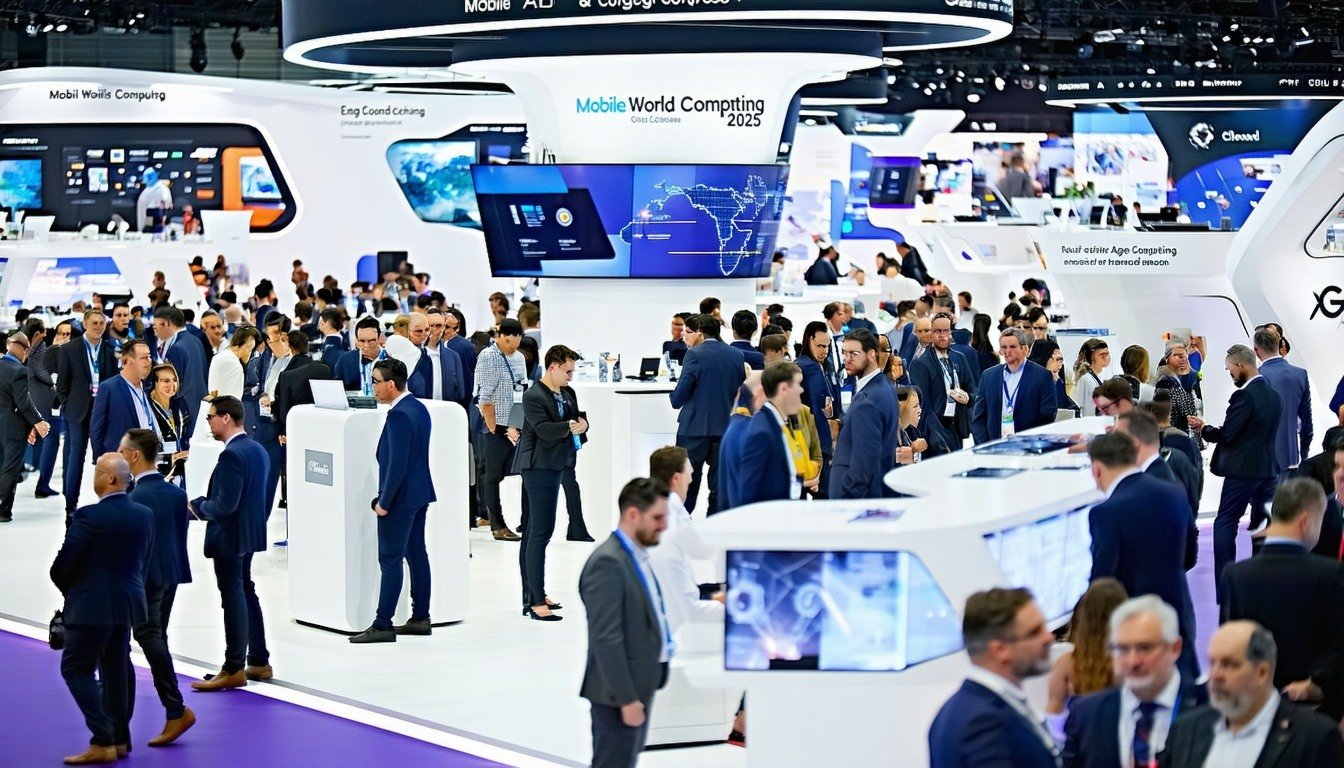If you couldn’t make the trip to Barcelona to attend Mobile World Congress (MWC) 2023 or you didn’t get your hands on virtual passes, don’t fret. Several ABI Research directors and analysts attended MWC 2023 and shared their thoughts in an insightful whitepaper. In this post, we give you a taste of those findings by sharing seven interesting quotes from our attendees. These findings should help you conceptualize the prevailing themes that swirled around the showroom floor at Fira Gran Via this year.
Malik Saadi
Malik Saadi, Vice President of Strategic Technologies, shared the following thoughts on the trip to Spain for MWC 2023.
“For years, MWC has been a stage for hardware technology flexing where industry players exhibit their latest products, proofs of concept, and solutions across the entire supply chain from mobile devices and wearables to mobile network infrastructure and computing systems. This year marks a significant shift from its traditional way of pitching innovation. In this year’s show, most industry players focused on fostering partnerships around their technologies to create relevant ecosystems and provide adequate solutions to address key pain points across different industry verticals. The show was also notably different this year, with fewer hardware kits exhibited and more focus on software. This is now a typical development path as the industry is moving toward virtualized networks across the entire infrastructure stack, including RAN, core networks, cloud, and edge computing.”
Dimitris Mavrakis
Dimitris Mavrakis, Senior Research Director, also made the trip to Barcelona for MWC 2023. He discusses the role of Groupe Speciale Mobile Association (GSMA) at this year’s event.
“Last year’s MWC key message was about enterprise applications and monetization. This year’s MWC saw a few developments, including the launch of GSMA’s Open Gateway API initiative, which aims to attract developer interest and expose functionality aggregated from multiple operators into a single platform for developers to consume. The launch occurred precisely 10 years after GSMA’s OneAPI announcement, and the same group of mobile operators spearheaded the launch of both initiatives. There are several reasons that OneAPI failed – and pretty much all operator API initiatives a decade ago, but now the market is more mature, and the focus is likely different.”
Related Content:
David McQueen
Our next insight from MWC 2023 comes from Research Director David McQueen. As you’ll read, David noticed that this year’s event in Barcelona felt more similar to those he attended at other venues before the COVID-19 pandemic.
“It is no secret that the past 12 months since MWC 2022 have been an extremely challenging environment for players in the mobile devices industry. The global pandemic, geopolitical pressure, supply chain issues, and macroeconomic headwinds have conspired to hinder the sector’s collaboration, market development, and innovation. But when attending MWC 2023, there was some pre-pandemic familiarity about the devices market as the analyst circuit began in earnest on Sunday morning, bounding throughout the day from one smartphone vendor to another, attending essential briefings and launch events. While the roster of names may have changed from days of yore, Motorola, Honor, Xiaomi, Nokia HMD, and OnePlus still lined up to announce their latest devices and aspirations for the sector.”
Reece Hayden
Reece Hayden is an analyst for ABI Research’s Distributed & Edge Computing Research Service. Here, he explains how seasoned developers with plenty of experience are key to telco monetization. He even shares an example on display at MWC 2023.
“Previous years have seen idealistic discussions around the potential opportunities for distributed computing in emerging use cases, such as the metaverse, ubiquitous AI, and many others. However, MWC 2023 took a step back and recognized that operators, IT vendors, hyperscalers, interconnection providers, neutral hosts, and other ecosystem players must first focus on the most critical aspect before these can be realized – monetization.
Multiple conversations turned toward ‘how can we best utilize our existing distributed compute ecosystem (hardware, software, orchestration) to monetize enterprise and telco channels.’ The consensus is developer experience. Ecosystem stakeholders recognize that DevOps experience (including application development, deployment, and management) is the biggest hurdle to enterprise and telco distributed compute usage. This led many announcements and conversations to focus on: how can we improve developer experience; how can we reduce application ‘time to market’; and how can we improve edge-to-cloud visibility and portability.
Azure for Operators has recognized the importance of developer experience in the distributed compute continuum. At MWC 2023, it announced Azure Operator Nexus – a platform to support developers in deploying network functions across on-premises edge infrastructure and public cloud regions. With embedded automation, frictionless APIs, and carrier-grade infrastructure, this solution aims to improve the developer experience by simplifying the provisioning of new network services and on-premises applications.”
Yih-Khai Wong
Our Senior Analyst in the Strategic Technologies team, Yih-Khai Wong, is another analyst who attended MWC 2023 in Barcelona. Here are his thoughts on conversations centered around the necessity of collaboration in the edge computing market.
“Increasingly, as more players enter the market and edge technology advancements come to the forefront, vendors realize that just providing an edge compute solution/platform is no longer attractive enough to win customers. Businesses often have specific business challenges, use cases, and workloads that edge compute solutions need to address; implementing an off-the-shelf edge compute solution will not help.
Customers want specific vertical edge solutions with edge-native applications, rather than re-packaged public cloud applications. Conversations at MWC highlighted that edge compute ‘go-to-market’ targets are pivoting from IT to OT decision makers because ‘they have the money to spend.’ Vendors have realized this, and one way they address this gap is by collaborating with industry players and crafting verticalized solutions. For example, in the telco space, AMD is collaborating with Nokia in bringing its 4th Gen EPYC processors to Nokia’s Cloud RAN solutions, helping CSPs manage energy costs and meeting carbon reduction targets at the network edge.”
Eric Abbruzzese
Eric Abbruzzese is a research director at our global intelligence firm and is mainly involved with Augmented Reality (AR) and Virtual Reality (VR) research efforts.
“While metaverse was a major talking point at MWC 2023, Augmented Reality (AR) and Virtual Reality (VR) were only responsible for a portion of that. Still, many high-profile mobile hardware and network giants were present, with demonstrations and case studies across use cases. Some new XR hardware was on display, such as Xiaomi’s Wireless AR Glass Discovery Edition. On the network side relating to XR, NVIDIA was present at several partner booths, including Fujitsu and Ericsson, leveraging CloudXR for network-powered XR demos.”
Abbruzzese continues …
“Metaverse has taken some of the XR-specific momentum, but metaverse and XR play together quite often, so expect XR to hold a more prominent role at MWC in the future, both with and without metaverse.”
Dan Shey
Our last quote comes from Vice President of Enabling Platforms, Dan Shey. He offers what he saw at the show in terms of the Internet of Things (IoT).
“The IoT was quietly alive and well at MWC 2023, but its perception of growth and opportunity varied depending on the supplier type. One example is cellular Low-Power Wide Area (LPWA) (Cat 1, Cat M, NB-IoT), which will be the technology that carries most new IoT connections for mobile operators. However, not all operators believe they can profitably play in that market. Some want to shift to a more gateway-centric approach and more high-bandwidth applications in industrial, manufacturing, and smart city. Others see LPWA IoT as the growth engine, but only in developing markets.
A new challenge for operators is that the hype phase of cellular LPWA betrayed expectations and caused many markets to consider alternative connectivity options for low-power IoT applications in monitoring and tracking markets. One up-and-comer replacing cellular, particularly in developing world markets, is DECT 2020 NR, marketed in the Finland pavilion by Wirepas.”
Get the Paper to Uncover More Trends from MWC 2023
Our team of global technology researchers has so much more to share regarding what they saw at MWC 2023. From the most exciting smartphone announcements to the role of 5G connectivity, a vast sea of knowledge still awaits you. To gain these insights and set your company up for sustained success, download ABI Research’s whitepaper, Mobile World Congress 2023: The Hits, The Misses, And The Telco Disconnect.





